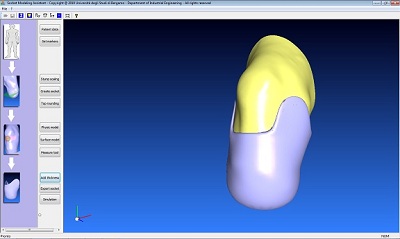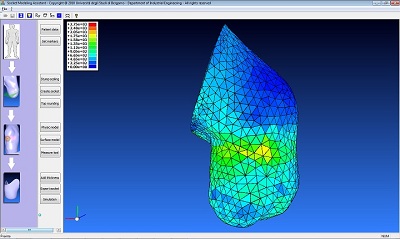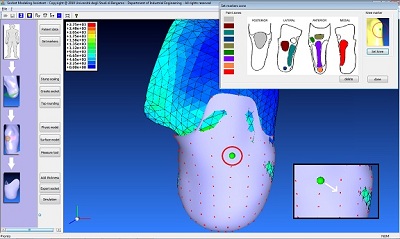

The Socket Modelling Assistant (SMA) is a virtual laboratory where the orthopaedic technician can work using virtual tools that permit to emulate the traditional procedures applied for socket manufacturing of a lower limb prosthesis. In SMA the socket design is centred on the data and on the digital model of the patient integrating the direct management of expertsí knowledge in order to guarantee a high level of product quality and improve the amputee quality of life. In this context SMA focuses on the process milestone, the socket design phase, where an excellent mastery of expert knowledge is necessary to realize a correct and functional product.
In the Socket Modelling Assistant (SMA), the new design process and the procedures to model the socket have been divided in 4 steps:
1) Patient case history: The first step consists in collecting patient case history and loading stump and bones 3D models. The patient characteristics are necessary in the next phases to apply rules and/or suggest the most appropriate procedures to the user during each step of the socket design process. All this information entered in the system substitute the paper form used in the traditional process to collect the patient case history and are used to guide the technician in an appropriate socket realization following the same rules applied during the traditional process. The patientís 3D models, acquired by magnetic resonance, are used as reference to design a custom socket shape. In the socket shape, is necessary to create offload and load zones that will match with stump critical parts. The SMA provides a marker tool, that permits to highlight stump critical zones with different colours. Once determined the zones, in the next phases the system can automatically modifies them on the base of the patient data.

2) Preliminary modelling: The aim of this phase is to generate a preliminary geometric model of the socket on which the technician will apply afterward other specific modifications to reach the final socket shape. It is constituted by a sequence of operations executed in automatic or semi-automatic way on the base of the patient characteristics, collected in the previous phase. After having imported the stump digital model composed by skin, muscles and bones, three main operations are carried out: stump model scaling, generation of socket reference surface and socket top optimization. In the following we briefly describe mentioned procedures.
Stump model scaling: In the traditional process the first operation applied on the stump positive plaster cast is the rasping procedure to reduce the stump volume. This is done since the socket, manufactured directly on the positive model, has to be perfectly close-fitting on the patientís residual limb. This procedure is reproduced in the SMA environment in automatic way, depending on patient data.
Generation of socket reference surface: Once scaled the model, the system automatically realizes a reference socket surface creating an offset with constant distance from the previously modified stump geometry. This surface constitutes the socket internal surface and will represent the starting point for the customized modelling;
Socket top optimization: An important procedure applied in the traditional process is to make round the low extremity of the positive plaster cast. Since normally the stump top has an irregular shape due to bone protuberances and scars, the orthopaedic technician creates a smooth and rounded area around the cast top, so that the model has a more functional shape with a view to wear the liner. This step is automatically executed from the system.

Customized modelling: This is the most important and critical phase of the whole process. Here the socket model is shaped directly on the stump digital model to be perfectly customized on each specific patientís anatomy. In the traditional process the technician first identifies with markers the areas on the positive model , which have to be modified and then starts to modify these zones adding or removing plaster. The SMA provides a virtual utensil , which can interact with a physic-based model of stump, and can push and pull the model, simulating the action of adding or removing plaster. The dimension of the cursor working area can be modified manually by the user. It is very similar to the real tools used by technicians in the traditional process to manipulate the plaster cast. Interaction with stump physic-based model is even possible with haptic-devices. Furthermore, the SMA can automatically modify the critical zones depending on the markers tool settings.
3) Finalization modelling: In the traditional process, after all the operations applied on the positive plaster cast, the technician creates directly on this model the socket. After the customized modelling, the socket model has to be finalized moulding the upper edge and giving a final thickness to the model. A specific tool allows the user to obtain really smooth and harmonious deformations, since it permits to act on the single surface control points of the model. It can work on different sections of the model, both horizontal and vertical. Moving the control points, the surface is modified in a homogenous way and it is also possible to scale the surface in the different sections. The operation of socket thickening is automatically executed by the system creating a surface offset outwards. This generated offset surface represents the socket external surface and the offset distance is the final socket thickness. Such as in the traditional process, the distance value is decided in relation to the patient weight.